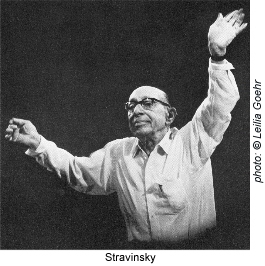|
The first issue of Tempo for
which David Drew was responsible as Editor was a double issue (No. 97, autumn
1971) in memory of Stravinsky. It contained a 22-page musical supplement
bearing the title
CANONS AND EPITAPHS
IN MEMORIAM
I.S. |
The contributors were Berio, L
Berkeley, Birtwistle, Blacher, Maxwell Davies, Denisov, Maw, Tippett,
Schnittke, Wood.
A second supplement (26 pages)
appeared in the following issue, with contributions from Boulez, Copland,
Carter, Goehr, Lutyens, Milhaud, Sessions.
For the contributors the only
guidelines were with regard to instrumentation and length: any selection of
instruments from the combination required for Stravinsky's own Double Canon and
Epitaphium; and a similar length. Canonic textures were not stipulated.
Each of the contributions -
except for the extensive and elaborate one by Pierre Boulez - was broadcast by
the BBC (producer: Stephen Plaistow) during daytime programme-breaks on the
first anniversary of Stravinsky's death. In the evening the complete
collection, minus Boulez, was transmitted as a single entity.
On 17 June 1972, the Westminster
Festival (Director: Michael Emmerson) presented at St John's Smith Square a
concert by The London Sinfonietta commemorating Stravinsky's ninetieth first
anniversary. The structure of the programme, devised by David Drew, combined
Stravinsky's own works with the complete set of 'Canons and Epitaphs',
including the world premiere of Boulez's contribution - an elaborately aleatory
piece entitled …explosante-fixe…. Performed on this
occasion by Sebastian Bell (flute), Antony Pay (clarinet), Elgar Howarth
(trumpet), and Nona Liddell (violin), ...explosante-fixe…. was
then withdrawn and became another of the composer's celebrated
works-in-progress - eventually to re-emerge in a very different and more
expansive form, under the original title.
The following text is
transcribed from the programme-leaflet, omitting only the brief notes on the
Stravinsky pieces (provided by Eric Walter White). The programme-leaflet was
designed by Guy Brabazon, and associated with the concert was an exhibition at
St John's, Smith Square, of Stravinsky photographs by Laelia Goehr.
|
Stravinsky
17 June
1882 - 6 April 1971
'Stravinsky's
art represents a profession of faith in the value and importance of music to
which his work lends new glory.' |
| Elliott Carter, 1971 |
|
St John's, Smith Square,
17 June 1972
Tonight's programme
of works by Stravinsky is interspersed with the 'Canons and Epitaphs' composed
in his memory. The latter - which are receiving their first public performance
tonight - were contributed to two recent issues of TEMPO (the quarterly review
of modern music) by seventeen leading composers: eight from the UK, three from
the USA, two each from France and the USSR and one each from Germany and Italy.
It was suggested to the composers that they use some or all of the instruments
required for two similar compositions by Stravinsky himself - his Epitaphium
for flute, clarinet and harp, and his Double Canon for string quartet. Although
the results are 'miniatures', they range in duration from 25 seconds (Tippett)
to 5½ minutes (Lutyens), and create a time-world of their own to which
the choice of Stravinsky's own works is necessarily related.
The programme divides into
two parts and six variously symmetrical sections (lasting, respectively, about
7', 24', 20', and 10', 23', 11'). There will be no pauses between the pieces
comprising each section. |
| David Drew, June 1972 |
| I |
Elliott Carter
|
Canon for 3 (muted trumpets) |
| |
Stravinsky
|
Epitaphium (1959) |
| |
Stravinsky
|
Double Canon (1959) |
| |
Boris Blacher
|
Canon (violin, cello) |
| |
Peter Maxwell
Davies |
Canon (flute, clarinet, harp, string quartet) |
| |
Stravinsky
|
Fanfare for a New Theatre (1964) for 2 trumpets |
| |
|
|
| II |
Stravinsky |
Pastorale (1907, arr. 1933) for violin and piano |
| |
Nicholas Maw
|
Epitaph-canon (flute, clarinet, harp) |
| |
Aaron Copland
|
Threnody (flute, string trio) |
| |
Hugh Wood
|
Canon (flute, clarinet, harp, string quartet) |
| |
Stravinsky
|
Duo
Concertant (1932) for violin and piano |
| |
|
|
| III |
Stravinsky
|
Madrid (1917) for two pianos |
| |
Luciano Berio
|
Autre fois-Berceuse canonique (flute, clarinet, harp)
|
| |
Roger Sessions
|
Canons (string quartet) |
| |
Michael Tippett
|
In
Memoriam Magistri (flute, clarinet, string quartet) |
| |
Alfred Schnittke
|
Canon (string quartet) |
| |
Stravinsky
|
Sonata (1944) for two pianos |
| IV |
Pierre Boulez
|
…explosante-fixe… |
à fin - d'évoquer
- de conjurer
|
Igor Stravinsky
son absence |
| |
|
 |
| |
17
juin 1972: pour cette version, la décision et le parcours: De
participant à participant, le signal se transmet; venant de transitoires
différentes (qui caracterisent leur propre expansion) tous convergent
vers l'originel pour s'y dissoudre-résoudre l'activité multiple
et insubordonnée selon l'unité de la disparition.
P.B. |
| |
|
|
| V |
Stravinsky
|
Three Little Songs (1913) for voice and piano |
| |
Harrison
Birtwistle |
Tombeau (flute, clarinet, harp, string quartet) |
| |
Darius Milhaud
|
Canon (string quartet) |
| |
Stravinsky |
'The Drake' (1920) for voice and piano |
| |
Lennox Berkeley
|
Canon (string quartet) |
| |
Alexander Goehr
|
Canonic Chorale (flute, clarinet, harp)
Played
simultaneously with the first of Stravinsky's Three Pieces for string
quartet |
| |
Elisabeth
Lutyens |
Requiescat (soprano, string trio)
Lines from William Blake's
'Couch of Death'. (All was still, the moon hung not out her lamp…)
|
| |
Edison Denisov
|
Canon (flute, clarinet, harp) |
| |
Stravinsky |
'A
Russian Spiritual' and 'Tilimbom' (1920) for voice and piano
|
| |
|
|
| VI |
Stravinsky
|
Septet (1953) for clarinet, horn, bassoon, piano, violin,
viola and violoncello |

|


